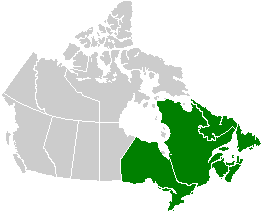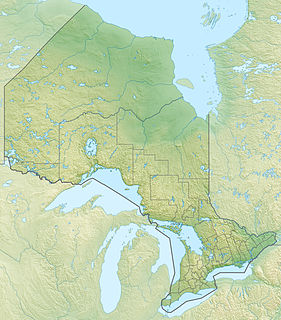
Lake Timiskaming or Lake Temiskaming is a large freshwater lake on the provincial boundary between Ontario and Quebec, Canada. The lake, which forms part of the Ottawa River, is 110 kilometres (68 mi) in length and covers an area of almost 295 km2 (114 sq mi). Its water level ranges between 175 m (574 ft) and 179 m (587 ft) above sea-level, with a mean annual average of 178.4 m (585 ft). The lake is in places up to 216 m (709 ft) deep. There are several islands on the lake, notably Mann and du Collège Islands.

The Ekati Diamond Mine ("Ekati") is Canada's first surface and underground diamond mine. It is located 310 km (190 mi) north-east of Yellowknife, Northwest Territories, and about 200 km (120 mi) south of the Arctic Circle, near Lac de Gras. Until 2014 Ekati was a joint venture between Dominion Diamond Mines (80%), and the two geologists who discovered kimberlite pipes north of Lac de Gras, Chuck Fipke and Stewart Blusson each holding a 10% stake in the mine, until Fipke sold his share to Dominion.

The Monteregian Hills is a linear chain of isolated hills in Montreal and Montérégie, between the Laurentians and the Appalachians.

Volcanology of Canada includes lava flows, lava plateaus, lava domes, cinder cones, stratovolcanoes, shield volcanoes, submarine volcanoes, calderas, diatremes, and maars, along with examples of more less common volcanic forms such as tuyas and subglacial mounds. It has a very complex volcanological history spanning from the Precambrian eon at least 3.11 billion years ago when this part of the North American continent began to form.

The New England hotspot, also referred to as the Great Meteor hotspot, is a long-lived volcanic hotspot in the Atlantic Ocean. The hotspot's most recent eruptive center is the Great Meteor Seamount, and it probably created a short line of mid to late-Cenozoic age seamounts on the African Plate but appears to be currently inactive.

The Ottawa-Bonnechere Graben is a geological structure that coincides with a 55 km (34 mi) wide topographic depression extending from near Montréal through Ottawa. It is part of the St. Lawrence rift system that also includes the seismically active Saguenay graben. This rift valley was formed when the Earth's crust moved downward about a kilometre between two major fault zones known as the Mattawa and Petawawa faults. The length of the graben is about 700 km (435 mi).
The Attawapiskat kimberlite field is a field of kimberlite pipes located astride the Attawapiskat River in the Hudson Bay Lowlands, in Northern Ontario, Canada. It is thought to have formed about 180 million years ago in the Jurassic period when the North American Plate moved westward over a centre of upwelling magma called the New England hotspot, also referred to as the Great Meteor hotspot.

The Buffalo Head Hills kimberlite field is a group of kimberlitic volcanic pipes or diatremes in north-central Alberta, Canada. As of 2011, 41 kimberlite pipes, of which 28 are diamondiferous, had been identified in the field. They were emplaced during Late Cretaceous to early Paleocene time.

The Birch Mountains kimberlite field is a cluster of kimberlitic volcanic pipes or diatremes in north-central Alberta, Canada that were emplaced during a period of kimberlitic volcanism in the Late Cretaceous epoch. As of 2011, 8 diatremes had been discovered in the field, and diamonds and microdiamononds had been recovered during sampling programs.
The Fort à la Corne kimberlite field is a 104- to 95-million-year-old diamond-bearing kimberlite field in east-central Saskatchewan, Canada. Its kimberlite pipes are among the most complete examples in the world, preserving maar-shaped craters.

The Northern Alberta Kimberlite Province (NAKP) consists of three groups of diatremes or volcanic pipes in north-central Alberta, Canada, most of which are kimberlites and some of which are diamondiferous. They are called the Birch Mountains (BM), Buffalo Head Hills (BHH), and the Mountain Lake cluster (ML), and they were discovered between about 1990 and 1997. Most of the diatremes were emplaced during the Late Cretaceous Epoch although a few are as young as early Paleocene.

The Lac de Gras kimberlite field is a group of Late Cretaceous to Eocene age diatremes in the Northwest Territories, Canada.
The Kirkland Lake kimberlite field is a 165 to 152 million year old kimberlite field in the Kirkland Lake area of northeastern Ontario, Canada.

The Mountain Lake cluster consists of two diatremes or volcanic pipes in Northern Alberta, Canada. It was emplaced during a period of kimberlite volcanism in the Late Cretaceous epoch.
The Churchill kimberlite field is a kimberlite field near Hudson Bay in Nunavut, Canada. It was formed during three magmatic events between 225 and 170 million years ago. The proposed source of volcanism has been the New England and Cape Verde hotspots.

The volcanology of Eastern Canada includes the hundreds of volcanic areas and extensive lava formations in Eastern Canada. The region's different volcano and lava types originate from different tectonic settings and types of volcanic eruptions, ranging from passive lava eruptions to violent explosive eruptions. Eastern Canada has very large volumes of magmatic rock called large igneous provinces. They are represented by deep-level plumbing systems consisting of giant dike swarms, sill provinces and layered intrusions. The most capable large igneous provinces in Eastern Canada are Archean age greenstone belts containing a rare volcanic rock called komatiite.

Volcanology of Northern Canada includes hundreds of volcanic areas and extensive lava formations across Northern Canada. The region's different volcano and lava types originate from different tectonic settings and types of volcanic eruptions, ranging from passive lava eruptions to violent explosive eruptions. Northern Canada has a record of very large volumes of magmatic rock called large igneous provinces. They are represented by deep-level plumbing systems consisting of giant dike swarms, sill provinces and layered intrusions.
The Great Meteor hotspot track, also referred to as the New England hotspot track, is a vast trail of hotspot magmatism in the Northern Hemisphere. It extends over 5,800 km (3,604 mi) from Nunavut in Northern Canada to the northern Atlantic Ocean. Volcanism in the hotspot track was produced by the New England or Great Meteor hotspot, with the oldest magmatic activity dating back at least 214 million years ago during the Late Triassic period. This makes the Great Meteor track one of the oldest hotspot tracks on Earth. It contains over 80 volcanoes, with the most recognizable ones located in the Atlantic Ocean where they form seamounts.
Diamond Lake is the name of at least nine different lakes with the same name in Ontario, Canada.

The Matabitchuan River is a river in Nipissing and Timiskaming Districts, Ontario, Canada.














